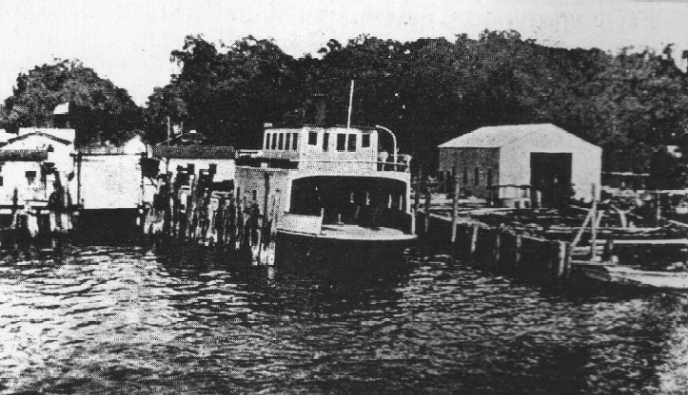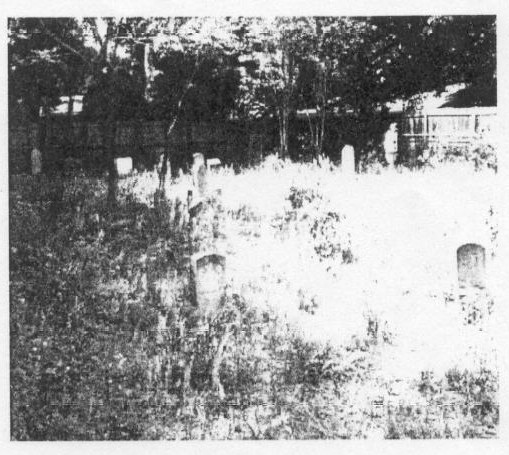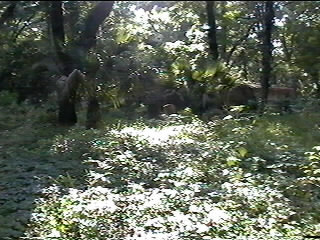
The Arlington Ferry 1920's. (ferry1.jpg)

The Arlington Ferry 1920's. (ferry1.jpg)
For several years Floral Bluff, west of Egleston,
served as the primary steamboat landing place on the east bank of the St.
Johns River. The railroad encouraged further settlement there. The community
developed on the site of a fifty-seven acre grant given to Francis Richard,
called Parque. Richard's claim, confirmed in 1825, ran in a narrow north-south
strip along the river. The south part of the Jacksonville University campus
presently occupies a part of Richard's Parque claim. Perhaps because of
the landing there, the first post office in the area was established at
Floral Bluff in 1887. Albert Frieseke, who maintained a store beside the
dock at Floral Bluff, served as the first postmaster. The mail arrived
daily in a pouch via ferry from Jacksonville. From Floral Bluff it was
distributed to other post offices to the east, including Gilmore, sixteen
miles distant. After the removal of the railroad, William Sherman, a local
black resident, served as the local "star route carrier," transporting
the pouch by mule or foot each day. Sherman died in 1941 at age 97.
The original plat for Floral Bluff was
filed March 1, 1887 by Gilbert H. Shepard. The plat contained merely four
blocks, which ran east from the landing at the St. Johns River along the
north edge of what is today Arlington Road. The principal early nineteenth
century resident of Floral Bluff was Robert Bigelow (1797-1868), a trustee
of the Francis Richard estate, who constructed a large residence on the
heights, overlooking the river. An extensive orange grove surrounded his
house, extending to the water's edge. Bigelow's house and plantation, later
called the Bacon Place, provided the location for many moving pictures
filmed in Jacksonville and Arlington during the short period between 1915
and 1920 when the industry prospered in the two communities. His daughter,
Eugenia Bigelow
( 1837-1898), taught at the Egleston Heights public school in 1890.
The JM&P ran two trains a day from
the river landing to the beach, making stops at Egleston. Verona, Cohasset,
and Gilmore. On one of its first runs the small engine stalled while climbing
a bluff. The passengers had to disembark and help it over the hill. Thereafter.
the JM&P became known as the "Jump, Men & Push Railroad." In 1893
the line changed hands. The new owners extended the tracks to South Jacksonville
(now San Marco). Arlington, said one resident of the area, thereupon "lost
some of its prestige." To reach South Jacksonville, the company constructed
a bridge across the mouth of the Arlington River. The bridge, recalled
one resident of the time, "was a source of trouble to boat owners and an
unsightly thing for all Pottsburg Creek residents." The railroad did not
run long. Low revenues apparently led to a discontinuation of service in
1895. John Stockton purchased the rolling stock, held it for a time, and
then sold it to H.H. Buckrnan in 1899. Buckman in turn sold the right-of-way
to the Mayport Terminal Company. The rails, according to one contemporary
observer, were taken up and shipped to Cuba, the bridge dismantled, and
the pilings removed. Thereafter, said the same correspondent, "We had a
clear river front view again and our creek was open once more."
During the few years that it provided service
between Arlington and Burnside Beach, the railroad undoubtedly inspired
development along the line, speeding settlement of Egleston, Verona, Cosmo,
and Gilmore. The line's abandonment, in turn, led soon to the demise of
the settlernent at Egleston. Although more than two decades passed before
the Methodist Church was relocated, many buildings were soon torn down,
sorne burned, and others moved. The hotel was barged southward to Arlington,
where it became the residence of Mrs. R.E. Colcord, founder of the Eastern
Shore Woman's Club, later renamed the Arlington Woman's Club.
As the century neared its end, Jacksonville's
reputation as one of Florida's premier winter resorts was challenged by
the development of cities in southeastern Florida. Upon completion of a
rail line reaching to the southern tip of the peninsula, Miami and West
Palm Beach became the destination of choice for visitors and wealthy northerners
seeking winter home sites. The tourist industry followed them. North Florida
was dealt a second economic blow in the winter of 1894-1895 when the "Great
Freeze" effectively destroyed its citrus industry. The cultivation, processing,
and shipping of oranges had been an important staple of trade along the
St. Johns River since the 1870s. In north Florida the business evaporated
in the winter of 1895-96. In many communities people whose property values
disappeared simply took off. William Matthews' groves in Arlington were
among those destroyed by the great freeze. Production of citrus in Florida
thereafter shifted to warmer parts of the peninsula, south of New Smyrna
Beach. Jacksonville's once prosperous citrus shipping industry never resumed
a role in the local economy.
Abandonment of the railroad and the great
freeze struck two blows at the east bank communities. Recovery came slowly.
The area's development paused for more than a decade before resuming with
noticeable vigor. Creation in the late part of the century of post office
branches east of the St. Johns River in Duval County mark Arlington's population
shifts. Floral Bluff received the first office in 1887. Following completion
of the JM&P rail line, a post office branch was organized in 1889 at
Egleston Heights, no more than a mile eastward. It merged with the Floral
Bluff office in 1895. The Verona office, created in 1888, became the Gilmore
office in 1901. The main Arlington office, established in 1894, was first
called Matthews and located at the water's edge in what is today Clifton.
It became the Arlington office only in 1912 when it was relocated to the
northwest corner of University Boulevard and Arlington Road. Not until
1954 was it merged into the main Jacksonville office. The building remained
at the southwest corner of Arlington Road and River Bluff Road until 1972.


The Bigelow Cemetery
continued on jackvi11.htm ...............

